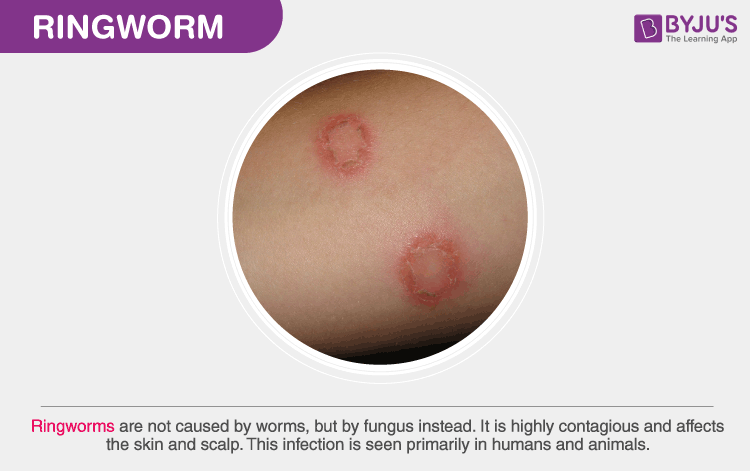What is Ringworm?
Ringworm, also known as dermatophytosis, is a fungal infection of the skin. It can affect both humans and animals. The infection initially appears as red patches on the affected areas that later spreads to different areas of the body. It majorly affects the scalp, nails, feet, groin and beard.

The ringworm fungus grows well in moist environment such as showers, bathroom floors and walls, swimming pools and also in between the skin folds. The vectors for this disease include pets such as cats and dogs. There are multiple forms of ringworm fungi, which affect different body parts.
Also Read: Modes of Transmission of Diseases
Types of Ringworm
Ringworm is classified based on the part of the body it affects.
- Tinea capitis: This fungal infection affects the scalp. It is also known by the name of scalp ringworm. (Tinea: Technical term for ringworm.) (Capitis: Latin for “of the head“)
- Tinea corporis: This fungal infection might occur in any part of the body. Thus it is known as body ringworm. (Corporis: Latin for “of the body”)
- Tinea cruris: This fungal infection affects the skin around the inner thighs, buttocks, and groin. It is also known as the Jock itch. (Cruris: Latin for “of the leg”)
- Tinea pedis: This fungal infection affects both the foot, in between the fingernails and toenails. It is also known as Athlete’s foot. (Pedis: Latin for “of the foot”)
Causes of Ringworm
Ringworm can be caused by the following ways:
- It spreads by skin contact with an infected person.
- It spreads from pets and cows. One should wash hands properly after playing with the pets.
- The fungus causing ringworm might be found lingering on clothes, comb, towels and brushes.
- These fungi are mainly present in the spores of soil. Coming into contact with such soil will result in an infection.
Symptoms of Ringworm
Ringworm symptoms vary depending upon the site of infection. The following are the common characteristic symptoms of ringworm:
- The skin of the feet becomes swollen and itchy between the toes. The soles and heels of the feet may also be affected.
- Itchy, scaly red spots appear on the groin area.
- Ringworm appears like an itchy, scaly, inflamed bald spot on the scalp.
- Ringworm on nails appear to be thick and abnormal in colour and shape.
- In the beard, itchy, red spots appear on the chin, cheeks, and the upper neck.
Also Read: Human Diseases
Diagnosis of Ringworm
Identifying ringworm infection is very easy. It primarily depends on the location and appearance of certain abnormalities in the skin such as bumps, scaly skins etc. Below are common diagnostic procedures done by doctors to diagnose ringworms.
- A black-light (also called UV-A or Wood’s lamp) is used to illuminate affected areas on the body. Presence of the fungal infection will glow under the light.
- KOH exam- The scrapings of the infected skin is collected and mixed with the prepared potassium (K) hydroxide (OH) solution. The KOH tests detect the fungi by removing the unaffected cells and leaving the fungal cells aside. The test results are checked under the microscope to detect ringworms.
- Skin biopsy – A small section of skin tissue is cut and examined under a microscope to detect fungi. It can detect a range of infections and disorders
- Fungal culture: A large swab is brushed over the infected areas. These samples are then sent to a lab for analysis to identify the causative microbes. This procedure helps to determine the best course of treatment for the infection.
Ringworm Treatment
A variety of products to treat ringworm infections are available in the market, such as antifungal cream, lotion, and powder. Sometimes, even home remedies are very effective.
- The best antifungal creams used for this infection are miconazole or terbinafine, which should be applied twice in a day on the infected region until the symptoms withdraw
- Amphotericin B is a very powerful fungicide that is used in the most serious cases of fungal infections
- There are many home remedies which help to prevent and control the infections. Using talcum powder is recommended as it helps to control sweating
- Home remedies include neem, which is a particularly effective antimicrobial and antifungal agent
Ringworm Prevention
Following precautions is one of the best methods to avoid ringworms. And more than often, lifestyle choices and decisions affect how the disease is spread. For instance, obesity increases the risk of ringworm.
- Maintain cleanliness and hygiene
- Wash hands with sanitizers
- Wear clean ironed clothes
- Avoid using communal pools
- Wear loose-fitting cotton clothes to avoid the accumulation of sweat
- The skin folds have to be kept clean regularly to avoid the accumulation of sweat and dirt between the creases
- Having a shower twice a day is also recommended
- Touching or scratching the itchy red patches would help to prevent it from spreading
Ringworm is not a serious disease, but it is a sign of poor hygiene and a precursor to many other major diseases and infections.
Also Read: Infectious Diseases
To know more about ringworm, its causes, symptoms, types and treatment, keep visiting BYJU’S website or download BYJU’S app for further reference.

thanks for the information